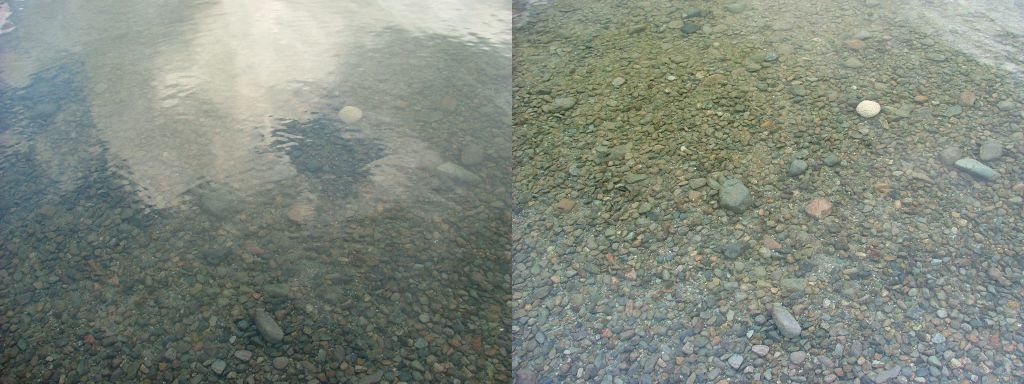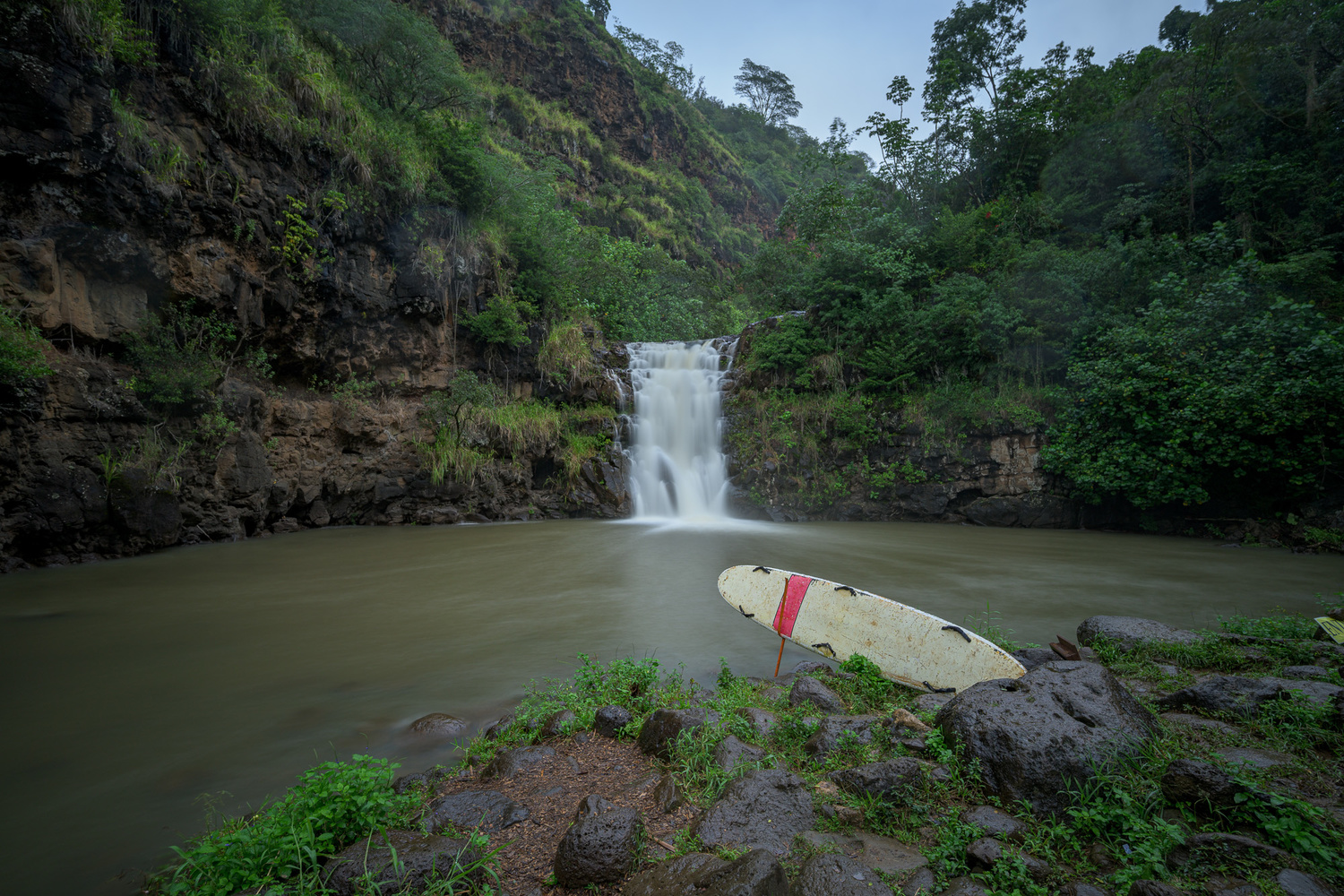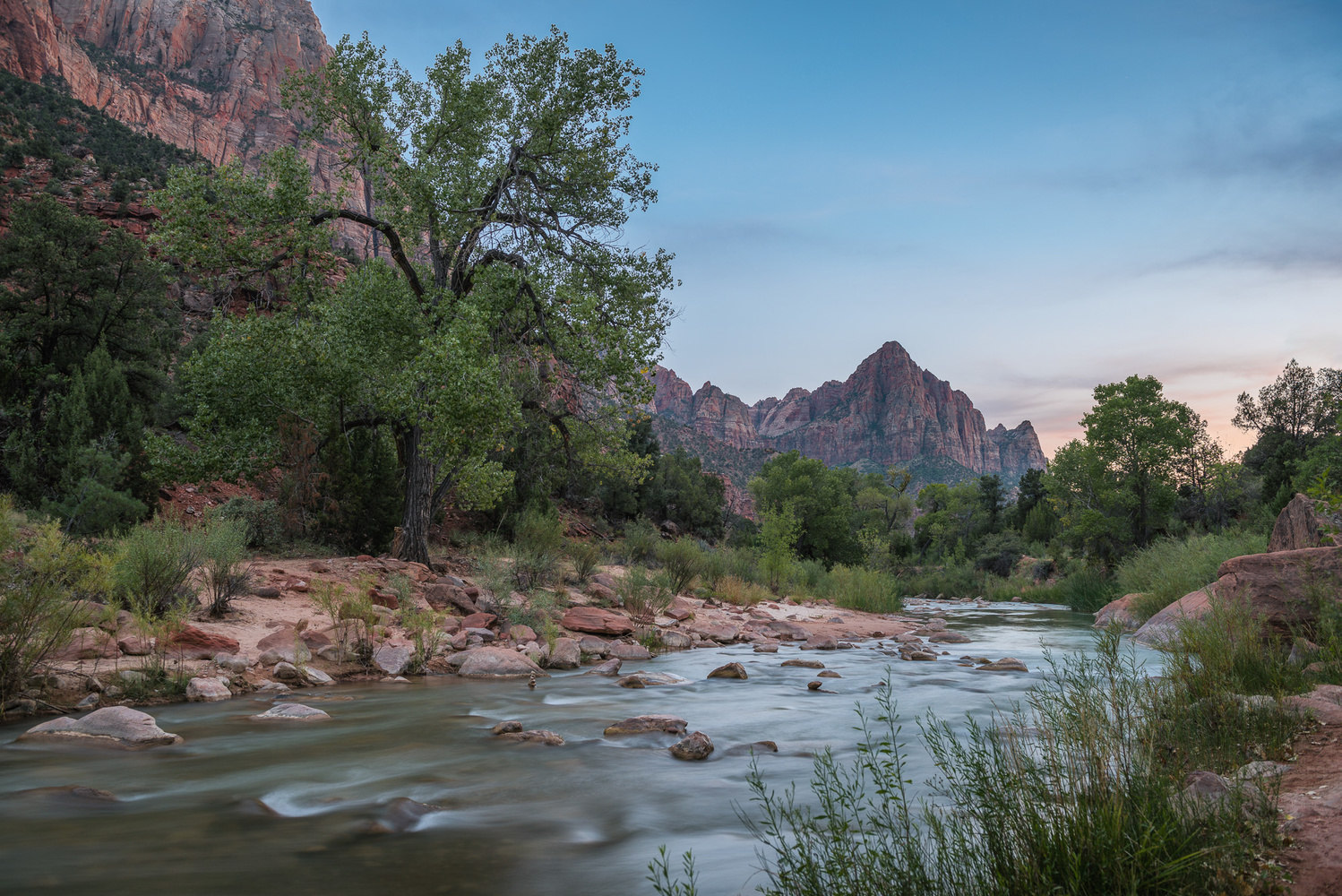With Photoshop, there’s not much need to carry around a book of physical filters anymore, but there are still two that you have to make sure you have. Want to know why?
You can now duplicate just about any effect from a physical filter with a digital effect. Whether it’s exposure blending and HDR to replace a gradient neutral density filter, channel adjustments for controlling contrast in a black and white conversion, or special effects like soft focus, you can get away with just doing it in Photoshop. However, the results of using a strong neutral density filter or polarizer just can’t be replaced in PS yet.
Let’s talk about polarization first. A polarizing filter like the B+W Circular Polarizer allows only light polarized to a specific angle to pass through. To a photographer, this translates into darker skies, reduced reflections, and diminished glare. Often a good choice for landscapes, seascapes, or shots where there’s glare on foliage, a polarizer can breathe life into a variety of shots.

Before and after, by Wikipedia user Amithshs (public domain)
In that example shot, you can see the polarizer shot on the right has visual information that just doesn’t exist in the before shot. While you might be able to dial in a ton of added contrast to try and bring back those details, it’s just not going to be practical.
A polarizer can also be used to emphasize reflections and other sources of polarized light, making them more intense. This can make a big difference when photographing pools of water, rainbows, or skylines. Amping up the reflection via added polarization just looks more natural than adding tonal contrast digitally or will at least get you closer to the desired result before you have to lean on that contrast slider. One thing to keep in mind with polarizers is to avoid the older style of linear polarizer; these can interfere with autofocus systems but are less common these days.
The case for the neutral density filter is a little less watertight. By stacking a series of exposures and blending them, you can replicate the impact of a neutral density filter to a reasonable degree. I've used this technique many times, for everything from waterfalls to star trails, and it's been a fun trick to learn.
Where the filter makes the biggest difference is in visualization. When you’re shooting a stack of frames to blend, it’s very difficult to see if you’re actually getting the degree of movement that you want. In contrast, by using an actual ND filter, you’ll be able to see the results instantly on image review and can adjust right in the field. For this waterfall example, I first just tried the stack, as I didn't want to dig into the bottom of my bag while in the rain just to find the filter. After the first couple of shots, however, I realized I just couldn't tell how long I needed to get the degree of smoothness that I was looking for.
If you’re using a camera without a built-in intervalometer, an ND filter is even more important, as the blending technique doesn’t tolerate camera movement well, and stabbing at the shutter 30 times is sure to introduce some movement. Using an ND won't save you from the issue of camera movement, however, so make sure you're using a good tripod and head and have everything locked down. The difference it does make is the ability to click it and forget it, making it both easier to set up and shoot in comparison.
Additionally, some techniques just work better with an actual long exposure, like light painting. While you can paint individual elements and composite later, the larger movements and patterns will have gaps in them as the shutter cycles, and you again run into the visualization issue.
A neutral density filter is also a pretty good value proposition, especially when you consider the availability of both 10-stop and variable ND filters. A variable ND like Tiffen’s 77mm 2-to-8 stop offering can take the place of multiple ND filters, especially if you combine it with step-up rings to fit smaller filter sizes. I’m personally a fan of just buying one very strong ND filter, as I find that most of the time I’m using it, I need all the stops I can get. My personal choice is Breakthrough Photography’s 10-stop ND, which has had some of the best sharpness and color results in testing.
Everything isn't golden with neutral density filters, however. Two big downsides are expense and workflow impact. For a usefully dark filter (3+ stops of reduction), you'll be looking at about $100. Cheaping out will mean severe color casts and a loss of sharpness. The first ND filter I bought made everything magenta and certainly wasn't saving me any work in PS! Apparently, good dark glass is expensive, so I'd suggest taking the hit only once; buy the largest size you'll expect to need. You can easily convert down in filter sizes, but going too small will mean buying duplicates in bigger sizes down the road.
The second impact is on workflow. While this article is meant to explore how you can save post-processing time with some smart filter usage, ND filters are more of a trade-off rather than a straight improvement, at least at the beginning. There's a bit of a checklist for proper ND usage. You have to lock down focus before you put the filter on, as the heavier strengths are impossible to see or autofocus through. Changing compositions means screwing the filter on, grabbing the shot, realizing you included an errant tree branch, unscrewing to adjust, and repeating (I speak from experience here). You'll also have to adjust some camera settings, as well as close off your viewfinder, if possible.
In my opinion, neutral density filters and polarizers still have a place in my camera bag. While you can imitate some of the impact they have on a shot in post, these two stand apart from other filter types in just how much of a difference they can make in a photo.







I love my Singh-Ray Vari-N-Trio filter that combines neutral density with circular polarizing and landscape color enhancement for good measure. Very expensive but a solid landscape investment. Normally yu cannot combine variable neutral density filters with polarizers as the former also use polarized glass. This allows me to shoot waterfalls and cut both exposure and glare.
Another filter I find very useful is my discontinued Zeiss Softar for portraits. There are micro lenses on the otherwise clear filter. It retains sharpness while providing a little soft diffusion at the same time. Specular highlights glow.
The third filter I cannot replace in photoshop are my star effects filters. I do not find that digital stars have the same quality and prefer the analogue effect. I will probably buy a tiffin black stocking diffuser this year for old school Hollywood diffusion and star effects.
Interesting choices! I don't do as much portraiture work, so it's interesting to see those mentioned.
For landscape work I highly recommend the Singh-Ray Vari-N-Trio series. Being able to use a circular polarizer and a variable ND together is worth the $540 list price for the 77mm (on sale now for $499 at B&H). I bought one used on Ebay for $300. It sounds crazy to spend as much on a filter as a lens but these really are that good for landscape work.
https://www.bhphotovideo.com/c/search?q=vari-n-trio&filters=fct_category...
Is there a significant advantage to using these over stacking a ND and polarizer? It looks pretty thick, so it isn't a huge savings in terms of vignetting. While you might not get the variable ND part, I find I just default a regular ND anyway.
Thanks for reminding me because I have a decades old 77 mm Softar filter that I've never used with a digital camera. It will actually fit on my 85 mm F1.4 D lens which is also 77 mm.
For the technique where you blend from multiple exposures, you don't actually need to visualize it as you can always adjust the amount of movement you're capturing in post by adjusting the number of exposures you're blending together. I do prefer to just do it in a single exposure in camera, but just saying...
Sure, it's more a case of making sure you actually have enough exposure time or captures. For instance, if you don't have enough frames to stack, you won't get a sufficiently smooth effect. With a ND filter, you can see immediately after capture if you've gotten enough blur.
For landscape work I highly recommend the Singh-Ray Vari-N-Trio series. Being able to use a circular polarizer and a variable ND together is worth the $540 list price for the 77mm (on sale now for $499 at B&H). I bought one used on Ebay for $300. It sounds crazy to spend as much on a filter as a lens but these really are that good for landscape work.
https://www.bhphotovideo.com/c/search?q=vari-n-trio&filters=fct_category...
The requirement for a circular polarizer only applies to DSLRs and SLRs when autofocusing. Linear polarizers work fine with mirrorless cameras since they don't depend on a mirror for autofocusing.
Interesting point. Many mirrorless cameras are making use of on sensor PD, but I'm not sure whether that's affected by linear polarizers to the same extent as circular polarizers. I'm not sure there's much point in going linear regardless.
Pretty sure you're commenting on the wrong article
I might be beating a dead horse, but I tend to include a set of Grad ND filters for landscape if:
a) you HAVE to have the shot done in camera and
b) reshooting is not an option.
Granted, you can really go a long way with a good exposure bracket, but only if there is neglegible movement. And you don't want fo find out in post that in fact it wasn't.
If the exposure difference is great enough to require NDs or a bracket, the NDs will be dark enough to cause problems with anything that sticks up above the horizon in to the ND area, in my experience.
True, it does. But it's a problem that can be seen on the back of the camera and hopefully dealt with on the scene of the crime while it's still hot.
And there are a gazillion different grad filters out there to aid in the quest of mitigating that effect.
Also, I'd like to think of bracketing vs. ND grads more as a set of options rather than exclusive religions. :-)=
Whatever gets the shot done is good for me.
I agree, both approaches will work - just a case of what you're comfortable with. I never got into grad NDs as I started with digital, and so much of my shooting technique is influenced by that.
Do you have any issues with vignetting when using step-up rings?
Some clarification as the terminology can be messy - I'm referring to large filter/ smaller lens. So with a 77mm filter on a 67mm lens, there's no vignetting in my experience.
Thanks. I understood the combination part, but I never tried it myself. Also, there are lots of filter step-down/up stacks you can buy, but I can imagine that at some point vignetting will happen, depending on your focal length. Better stick to one converter, which goes straight from one to the other thread...
While I find small vignetting (less than 1 stop) to be easily correctable in the raw converter of your choice, a different matter may arise:
When using ultra wide angle lenses, there might be a color/ polarization gradient across the frame, especially in the sky.
Because (without nerding out on math), the degree of polarization is very dependent on the angle between the sun, the sky and the camera, the left side of the frame covers a whole different arc/ angle than the right side of the frame. So, different polarization.
I think Gerald Undone did a video about that llast year or so.
Using a smaller filter on a larger diameter lens will cause vignetting, but I can't see how using a larger filter will ever cause vignetting. Disregarding a actual flaw in filter design or ring design, it should never be worse than using the filter on the native lens size.
Sounds unique. What makes that different than a regular polarizer?
The two filters you must have - is better.